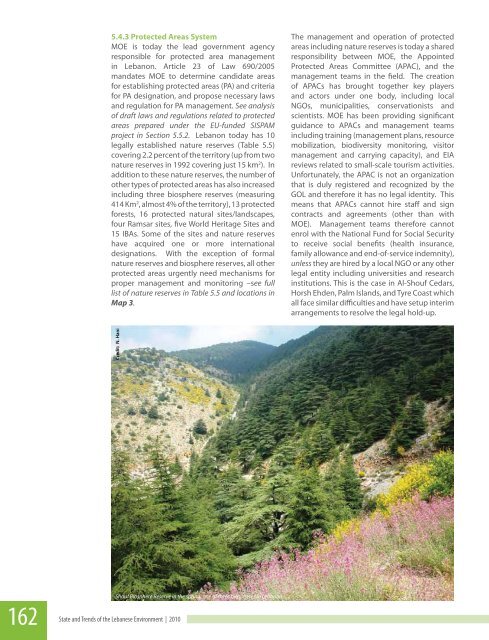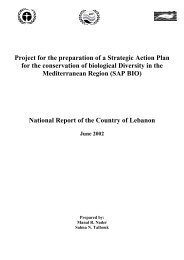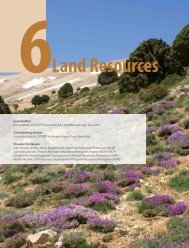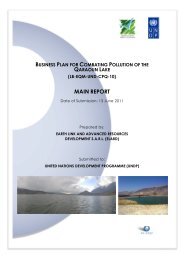Biodiversity and Forests
Biodiversity and Forests
Biodiversity and Forests
Create successful ePaper yourself
Turn your PDF publications into a flip-book with our unique Google optimized e-Paper software.
162<br />
5.4.3 Protected Areas System<br />
MOE is today the lead government agency<br />
responsible for protected area management<br />
in Lebanon. Article 23 of Law 690/2005<br />
m<strong>and</strong>ates MOE to determine c<strong>and</strong>idate areas<br />
for establishing protected areas (PA) <strong>and</strong> criteria<br />
for PA designation, <strong>and</strong> propose necessary laws<br />
<strong>and</strong> regulation for PA management. See analysis<br />
of draft laws <strong>and</strong> regulations related to protected<br />
areas prepared under the EU-funded SISPAM<br />
project in Section 5.5.2. Lebanon today has 10<br />
legally established nature reserves (Table 5.5)<br />
covering 2.2 percent of the territory (up from two<br />
nature reserves in 1992 covering just 15 km 2 ). In<br />
addition to these nature reserves, the number of<br />
other types of protected areas has also increased<br />
including three biosphere reserves (measuring<br />
414 Km 2 , almost 4% of the territory), 13 protected<br />
forests, 16 protected natural sites/l<strong>and</strong>scapes,<br />
four Ramsar sites, five World Heritage Sites <strong>and</strong><br />
15 IBAs. Some of the sites <strong>and</strong> nature reserves<br />
have acquired one or more international<br />
designations. With the exception of formal<br />
nature reserves <strong>and</strong> biosphere reserves, all other<br />
protected areas urgently need mechanisms for<br />
proper management <strong>and</strong> monitoring –see full<br />
list of nature reserves in Table 5.5 <strong>and</strong> locations in<br />
Map 3.<br />
Credit: N. Hani<br />
Shouf Biosphere Reserve in the spring, one of three biospheres in Lebanon<br />
State <strong>and</strong> Trends of the Lebanese Environment | 2010<br />
The management <strong>and</strong> operation of protected<br />
areas including nature reserves is today a shared<br />
responsibility between MOE, the Appointed<br />
Protected Areas Committee (APAC), <strong>and</strong> the<br />
management teams in the field. The creation<br />
of APACs has brought together key players<br />
<strong>and</strong> actors under one body, including local<br />
NGOs, municipalities, conservationists <strong>and</strong><br />
scientists. MOE has been providing significant<br />
guidance to APACs <strong>and</strong> management teams<br />
including training (management plans, resource<br />
mobilization, biodiversity monitoring, visitor<br />
management <strong>and</strong> carrying capacity), <strong>and</strong> EIA<br />
reviews related to small-scale tourism activities.<br />
Unfortunately, the APAC is not an organization<br />
that is duly registered <strong>and</strong> recognized by the<br />
GOL <strong>and</strong> therefore it has no legal identity. This<br />
means that APACs cannot hire staff <strong>and</strong> sign<br />
contracts <strong>and</strong> agreements (other than with<br />
MOE). Management teams therefore cannot<br />
enrol with the National Fund for Social Security<br />
to receive social benefits (health insurance,<br />
family allowance <strong>and</strong> end-of-service indemnity),<br />
unless they are hired by a local NGO or any other<br />
legal entity including universities <strong>and</strong> research<br />
institutions. This is the case in Al-Shouf Cedars,<br />
Horsh Ehden, Palm Isl<strong>and</strong>s, <strong>and</strong> Tyre Coast which<br />
all face similar difficulties <strong>and</strong> have setup interim<br />
arrangements to resolve the legal hold-up.





